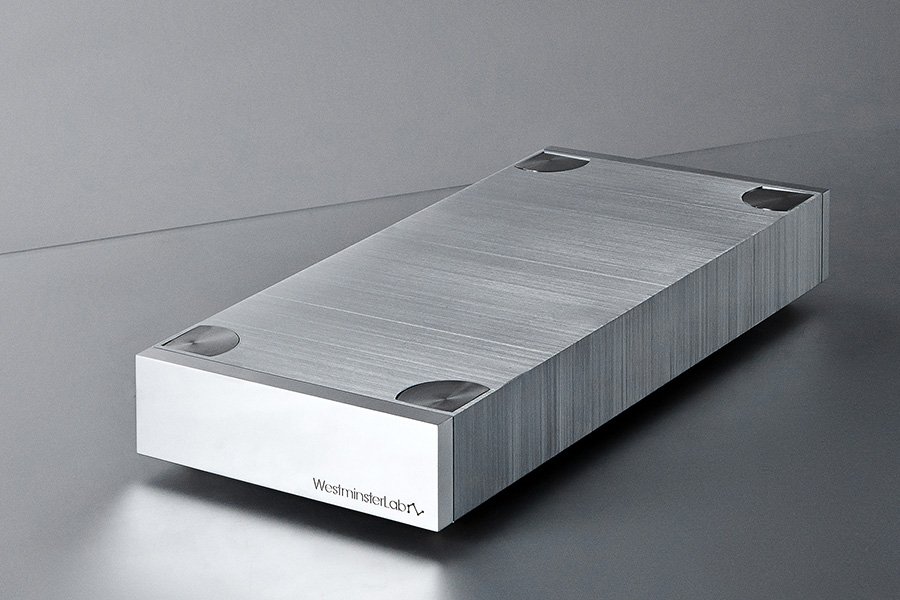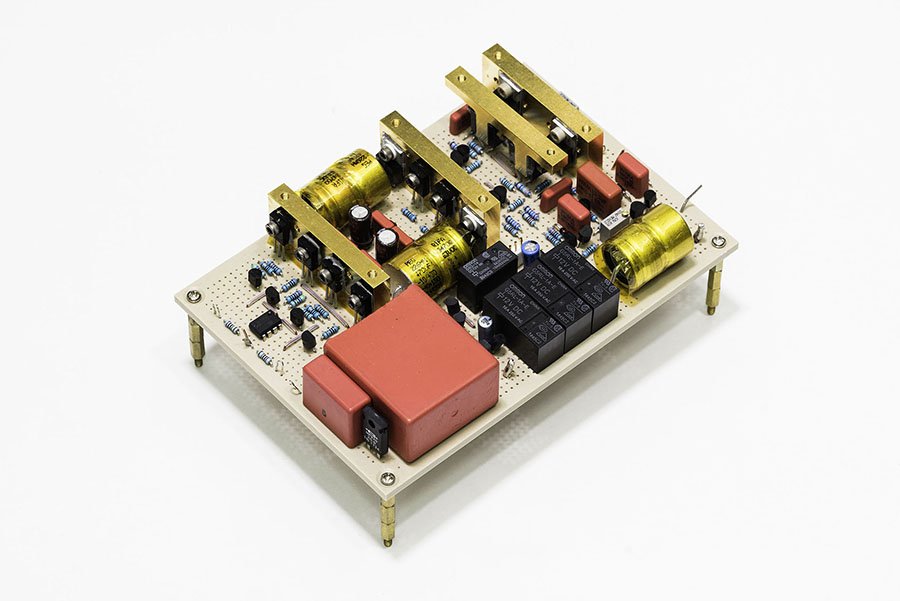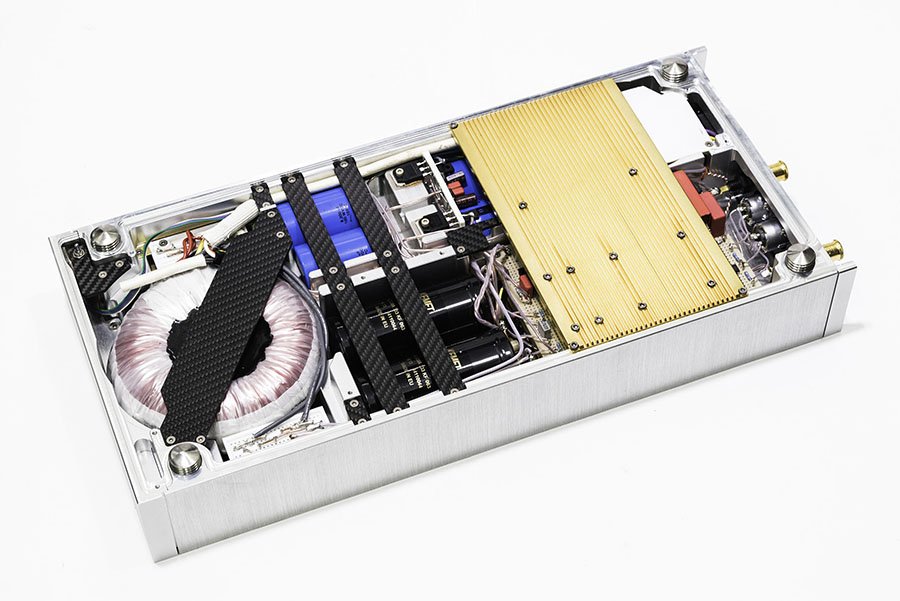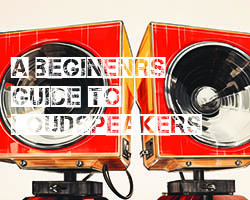Westminster Lab makes no claims as to how good it is, rather just invite you to enter into their ‘new dimension’ of music experience. According to them words are totally futile. But that would make for a short review, so, not known for keeping quiet, Janine Elliot wanted to tell readers about this unique amp costing £32 000.
Background and Build
The name WestminsterLab is a result of 29 year old boss Angus Leong and his two friends meeting in London to discuss starting a company making exotic hifi and the name they chose seemed to fit very well; Westminster has old school architecture but inside is a high-tech centre of the UK. This is an apt description, too, of his Unum power amplifier up for review here; with a minimalist mono-block design that could easily sit in the Tate Gallery and which hides considerable high-tech engineering ideas inside it. Angus took GCSEs, A-levels and appropriately both a Bachelor and Master degree in architecture whilst in Britain, though he is Hong Kong born from where the Unum is handcrafted and designed; only the cables department of the company is in the UK. He started listening to music at the age of 12 and soon realised he couldn’t afford the high-end products he loved so started making his own gear. Much later he met some friends and started making cables, and now he is manufacturing both the Unum and a variety of cables, some of which I used in this review.
At £32,000 for the basic Unum, £42,000 for the Unum Edition and £66,000 for the Unum Connoisseur these are by no means cheap, but the amount of hand crafting in these product puts most companies to shame, whatever their price. This is a 30kg block of 6082 aluminium, which is then machined down to 8kg for everything else to be tightly packed inside, taking the weight of the entry model to 21kg, rising to 23kg for the top Connoisseur model. Clues to the rise in weight relate to the addition of stainless steel, and improvements in design and components, which also put up the price. In the £44,000 model, for example, there is a better power supply, better matching of transistors and resistors and a gold plated heatsink. Facilities in the more expensive models include things like 12v remote trigger.
The finishes included ‘Premium Rose Gold’ for an additional £4,500.00 and ‘Platinum’ for £5,500.00. There are even options for further ancillary improvements to be made, such as replacing the gold plated copper heatsink with a dark glossy black DLC (Diamond Like Carbon) coated copper heatsink. This material is deposited onto the copper with a technology called Physical Vapour Deposition which offers, according to WestminsterLab, a durable surface which “enhances thermal and audio performance”. On each corner of the unit there are huge machined brass grounding spikes which you can screw from above to alter their height and then place stainless steel finishing corner pieces over the top once the two mono-blocks are made level.
The looks and construction are a major part of the design of each of the 23.2cm x 7.2cm x 50.1 cm mono units, though care in design of the electronics is equally painstakingly thought out. Components in this Class-A/b design are sourced from a wide variety of manufacturers and types, carefully chosen by both performance analysis and listening experiences. 
Rather than simply being soldered onto a cheap printed circuit board (PCB), components are instead installed onto a plastic PEEK chassis. Polyether ether ketone (PEEK) is a colourless organic polymer which comes from the polyaryl ether ketone (PAEK) family, which is used in engineering applications. Printed circuit board are of course the standard in the industry for their ease of use and low cost, as well as space saving qualities. In the good old days before PCB’s, components, as in my Leak Stereo 20, were connected directly to each other in what was known as a “point-to-point” construction, sometimes with terminal strips or “tag boards” or turret boards. This meant that routes for the components could be shorter than that on a PCB, but because the components were themselves further apart the size of the unit would be bigger, something of an anathema to most manufacturers from the 70’s. Whilst PCBs would reduce the overall surface area of components, one of their drawbacks can be unwanted effects from this impure transmission route; a mixture of metals and bad contacts. Signals from a component have to pass through a soldering point with its soldering pad connecting to a thin flat copper layer taking it all the way to the next soldering pad and soldering point before finally reaching the next component. Since RoHS even the use of solder has meant changing from a low-heat lead solder to a higher heating silver based solder which costs more to buy and heat up, doing anything but help the universe, and can have the side effect of poor or dry joints. I remember writing a piece in HiFi News when these changes first started, with some manufacturers noticing changes in sound quality, not just about effects of different solder, but also different materials in the components themselves, and even worries that the solder could come away from the PCB at low temperatures. WestminsterLab’s solution is, as I mentioned earlier, to use a machined plastic PEEK chassis which provides excellent dielectric qualities, being a thick plastic with equidistant holes for inserting components which are then soldered to the next component in the circuit, a bit like the practice wannabe designers, like myself, using ‘perfboards’ created their prototype designs.
In the Unum there is no chance of knocking components loose as this amplifier weighs a ton, and all joints are mechanically joined with hooks to give even greater join. They had considered a PTFE board as the dielectric, but it is very soft, so may not have held the components securely enough.
Next, fasteners and bracing materials needed to be well thought about; metal creates magnetism and eddy currents, so they decide to go for Titanium screws, which have a higher tensile strength than common stainless steel screws. Similarly, to affix transistors to the brass heatsinks, rather than using metal screws, Westminster Lab decided to use PEEK screws, which they believe give a clearer, purer and more direct sound over metal screws. They found PEEK was hard, stiff and stable enough, as well as being an excellent dielectric, so no eddy current.
In designing the circuitry use of ears was considered as important as looking at computer simulations or technical readings. WestminsterLab wanted to produce a pure and clean sound, reproducing as close as possible the original sources. That then made them consider what internal shielding should be used inside the solid aluminium frame, and ultimately how internal wiring should be constructed. A detailed investigation by WestminsterLab looked at materials for the wire, the dielectric and even looking at what degree of twisting should be deployed. In summary, Carbon fibre is extensively used as shielding materials for both amplifier and cables, with cabling twisted at various angles depending on where it is deployed in the circuit. What they found out was that capacitance and inductance change depending on the angle it is wound at; a big angle will generate a bigger capacitance and lower inductance they say. In their tests a single angle gave a particular resonance to a particular frequency range which iwas not good for multi-frequency musical signal. To solve this, they decided there should be different angles, coming up with their own self-formulated ‘Vari-Twist’ design, whereby the signal cable is twisted at varying angles throughout the circuit. The inductance of the cable keeps changing in order to minimize the resonance with particular frequencies yet at the same time interference and the magnetic field are still minimized. The art of cable design and manufacture is a big business, and in this review I also used WestminsterLab’s own mains and connector cables.
The unit itself has an off/on toggle on the underside below an etched out symbol next to the words ‘WestminsterLab’ which light up firstly red and then bright white when it is ready for listening to. It’s so nice not to see a simple circular hole for an LED to be inserted. To make the stencil they use an industrial process called EDM (Electrical Discharge Machining) to mill out the complicated graphic shape. A lot of thought has gone into even the indicator of these amplifiers.
At the back are Neutrik XLR’s; the male socket for input and a female for output ‘pre’ the amplification, so you can send the input to further amplifiers if you want to bi- or tri-amp. There is no need for labelling as the male/female XLRs tell you all you need to work out how to connect up. The loudspeaker binding posts are WBT. There is a slight dimple in the stainless-steel top corners of the Unum so they won’t slide about if put more than one unit on top of each other.
As the unit is quite shallow in size, fitting in a normal toroidal transformer is not easy, so they use an ‘O’ type transformer which is more efficient than usual toroidals, and, according to them, offers cleaner, purer and faster power due to its different iron-core design. Standard toroidal transformers are themselves very efficient, and Angus claims his USA made ‘O’ toroidal to be 95% efficient; with no leak from the core and low eddy current. A second toroidal is used for non-audio functions, such as controls, protection and the LEDs.
Power transistors are first mounted onto a single piece of copper and then mounting this piece of copper onto the aluminium chassis. Controlling their temperature through the clever heatsink helped keep the output sound more stable and dynamic, according to Angus. The power transistors are mounted close together inside a gold plated copper heatsink and then closed up like a sandwich; helping to keep them cooler and all operating at the same temperature. The body of the Unum is solid aluminium and this also acts as a heatsink. The whole amplifier was surprisingly cool in operation for a Class A/B product.
The amplification circuit itself was initially a total surprise to me in several ways. Firstly, the unit is quite shallow, kept very cool, and the amplification section only takes up a corner of the frame, so I assumed it was actually Class-D. Having a fairly small main toroidal power supply wasn’t what I expected either. This unit is actually Class A/B, though the Class-A first section only operates for around ½ Watt which is much less than I would normally like or expect; around 5 Watt would be a ball-park number for me. The Class-B section takes it to around 95 watts @ 8Ω RMS (around 190W peak). This is not a particularly big amp in terms of power, but what it really does well is control everything it plays.
I really did enjoy this amplifier more than I thought I could, and all was made even more enjoyable when using their cables. The Ultra XLR 1m interconnect is £3200, 2.5m Ultra speaker cable is £5,040 and their 1.5m Ultra mains cable is £3600.
Sound
The Oak and the Ash (The King’s Singers) is a very sparse recording and this amplifier gave the music all the space it needed to breathe, without any hint of pressure. Using my Graham Audio LS5/9’s as loudspeakers, the Minnesota Orchestra Pictures at an Exhibition, “The Hut of Baba-Yaga” Mussorgsky, had all the oomph needed to get the movement in full flow, but the mystery of the middle section had so much patience that it felt the music was slowing down. The kettle drum outbursts were clear and fast as they needed to be. Beethoven’s Seventh Symphony is my favourite of the nine, particularly – as a viola player – the second movement, which has a great solo for the instrument. This movement always gets me in floods of tears with its emotion and this performance from The Dresden Philharmonic Orchestra (Herbert Kegel) didn’t leave me dry. The saxophone in the Yuri Honing Trio “Walking on the Moon” was walking in air, contrasting with the urgency in the toms. Each instrument of the trio was positioned in their own well-defined space; the double bass and saxophone very forward in the soundspace; my Leak sends it all to the back in contrast, so I felt very much involved with the musicians.
My old favourite ‘New Orleans Bump’, Wynton Marsalis, includes trumpet, clarinet, banjo and drums, all carefully placed in the recording and this can sound a little rough using some amplifiers, especially the trumpet, but this amplifier kept it all under control and with no hint of bitterness. Wynton was born a year after me, but in his life as a trumpeter, composer, teacher, music educator, and artistic director of Jazz at Lincoln Center in New York City he has done so much to promote classical and jazz music, particularly to young audiences. The drum solo in Cotton Tail (Dee Dee Bridgewater) was precise and fluid. The audience applause in this live recording actually sounded like an applause, something some amplifiers are not that good at. But at £32K-£66K this monoblock amplifier pair should be good.
Only in Rickie Lee Jones Spring Can Really Hang You Up the Most, did I find that the vocal was a little less clear than some amplifiers; her voice is not always clear, but I had hoped this amplifier could de-mist the vocals like it did so well to the accompanying acoustic guitar. The problem is that if the voice sounds too clear then you know there is some top-heavy EQ going on, so getting it just right is not easy. She should still sound a bit like she is yawning throughout the piece. The house Krell Class-A KAV250a gave a sound that was further back in the soundstage, and once I had swapped from the WestminsterLab to the Krell I immediately wanted to go through the backache of re-plugging it back in. What the Unum did do, though, was make her voice more real than many amplifiers do. Whilst the Krell has a rather intimate relationship with the AC supply; a gigantic toroidal transformer, over 50,000 microfarads of filter capacitance, and a 2000VA rating, the WestminsterLab appears modest on paper with just 680VA.
This amp might be more Class-B than anything else but it was more in control and with less distortion than one would normally expect a Class-B amplifier to have. This amp had far more up its sleeve than its modest spec might suggest. The Unum has control, fun, space, excitement, speed and good looks, to the point I really didn’t want to give it back.
At the moment there is no distributor in Europe, but if you have the cash spare to buy a Unum you can do so directly from the manufacturer with a “build time” of a week for each basic mono model, rising to a month for the Connoisseur.
There are a number of amplifiers out there in this price range, so do consider them as well, but what WestminsterLab have done is aim for perfection, which cannot be done cheaply. Angus tells me “Over engineering is our game”. Cost is not a consideration in the building of this amp, and they begin with the middle, £44,000 model, and then created the other two models from this starting point. What WestminsterLab has done is forget business and just work to create good audio. If you want a pair, then you will be entering into an exceptional members-only club of fine audio.
Conclusion
‘E Pluribus Unum’ is the motto of the USA; “out of many, one”. In a world of many amplifiers WestminsterLab want there to be no other amplifier like the Unum, and in many respects this is the case.
This is a very special amplifier, one that amazed me, not only in its Rolls-Royce build, but also its unfettered, accurate and musical performance, and not putting aside its technological claims. It might be tame in terms of facilities and power, but the age of powerful monoliths is a tad old hat some would say.
All the care taken in design and assembly of this mono-block make for a very clean and very accurate sound. If you want lots of grunt and an extravert sound then you’ll need to look elsewhere. This one is just plain honest.
Build Quality: Superb attention to quality of build
Sound Quality: Detailed and well controlled audio, covering all frequencies with ease. Exceptionally low distortion for the Class-B stage
Value For Money: At £32,000 for the base model this is a considerable outlay, but for this you will get an excellent sound quality and a clarity and speed of sound that is addictive
Pros:
A unique product
Bass slam and speed
Accurate and musical performance
Low distortion
Impressive looks
Cons:
Modest Class-A side of 1/2W, but that Class-B stage is epic
Rather a lot of money
Price:
£32,000
SPECIFICATIONS
Power:
190 watts @ 8Ω
380 watts @ 4Ω
720 watts @ 2Ω
Power ( True RMS ):
95 watts @ 8Ω
190 watts @ 4Ω
360 watts @ 2Ω
Frequency Response: 5 Hz to 75 kHz, -1 dB, 10Hz to 40 kHz, ±0.1 dB
Distortion: (95 watts @ 8Ω) <0.1% @ 1 kHz
Signal-to-Noise Ratio: 103 dB, A-weighted
Input: 1 balanced XLR input
Output: 1 balanced XLR output
Input Impedance: 200 kΩ
Output Impedance: 0.10Ω
Dimensions: W232 x H72 x D501 mm
Weight: 21kg




















































































































































































































You must be logged in to leave a reply.